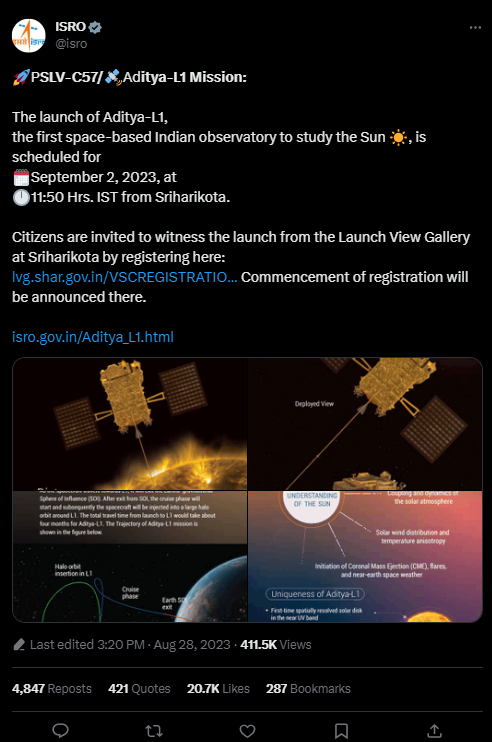Aditya-L1: The launch of Aditya-L1, India’s first solar-powered space mission, has been set for September 2, 2023, according to a Monday announcement from the Indian Space Research Organisation (ISRO). Aditya-L1 will spend five years researching the Sun. It will be launched from Sriharikota, Andhra Pradesh, aboard a Polar Satellite Launch Vehicle (PSLV) on September 2 at 11:50 am IST.
A Halo Dance Around L1 for Uninterrupted Solar Gazing

In order to save fuel and guarantee that the spacecraft gets a clear view of the Sun for the duration of its mission, Aditya-L1 will be put in a halo orbit around the Lagrange point 1 (L1) in the Sun-Earth system. A Lagrange point is a location in space where a spacecraft is stationary in one location, hence using less fuel. 1.5 million miles separate L1 from Earth. Aditya-L1, if positioned in L1, has the unique property of never experiencing a solar eclipse or occultation and being able to watch the Sun continually. An astronomical object is said to be under an occultation when another celestial body, such as a star or planet, completely blocks its light. A solar eclipse occurs when the Moon blocks the Sun from view. As a result, while every occultation is not an eclipse, every eclipse is an occultation.
Aditya-L1’s Scientific Mission to Unravel Sun’s Hidden Layers
Aditya-L1 will monitor solar activity and its impact on space weather in real time, according to ISRO, and is expected to be in operation for five years. Seven payloads, including two each of remote sensing and in-situ payloads, are included with Aditya-L1. These seven payloads will use detectors of electromagnetic, particle, and magnetic fields to study the Sun’s photosphere, chromosphere, and corona. The Sun’s atmosphere is made up of three layers: the photosphere, the chromosphere, and the corona. The photosphere makes up the deepest layer of the Sun’s atmosphere.
Aditya-L1’s Unique Position to Probe Sun’s Impact on Space Environment
Utilising the singularity of the unique location L1, the remote sensing payloads will study the Sun up close. Aditya-L1’s in-situ payloads will study particles and fields at L1 while they are in-situ. Aditya-L1 will therefore not only study solar dynamics but also carry out research on how the dynamics of the Sun affect the interplanetary medium. Aditya-L1 will deliver crucial data that is anticipated to aid researchers’ comprehension of coronal mass ejections, pre-flare and flare activities, particle and field propagation, the issue of coronal heating, and the dynamics of space weather.
Keep watching our YouTube Channel ‘DNP INDIA’. Also, please subscribe and follow us on FACEBOOK, INSTAGRAM, and TWITTER.